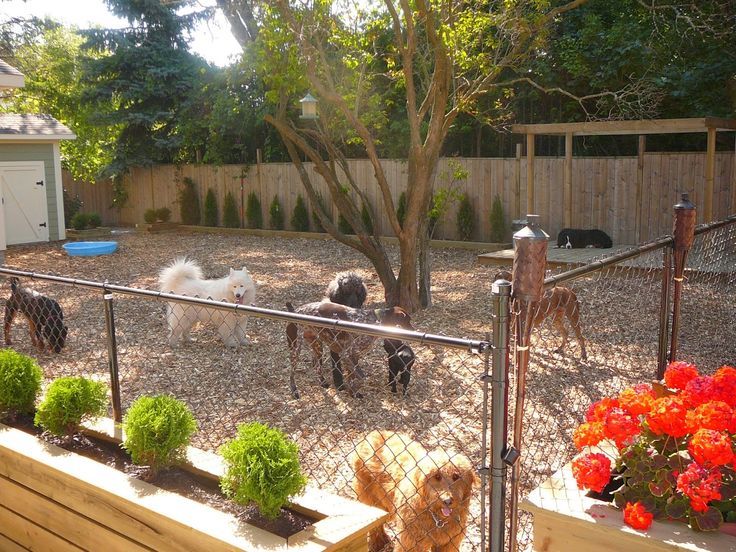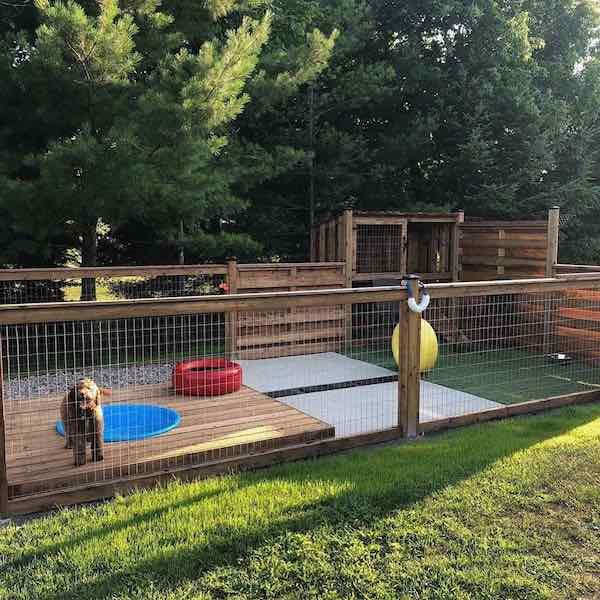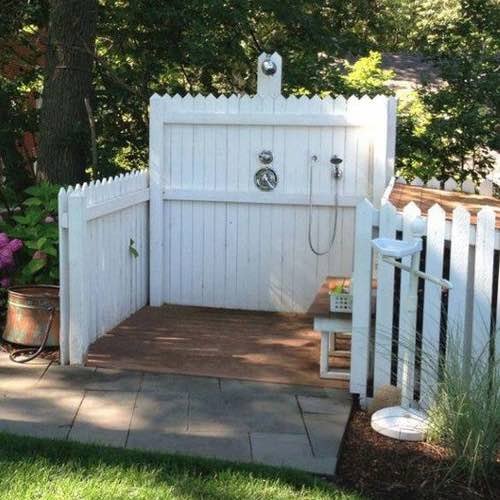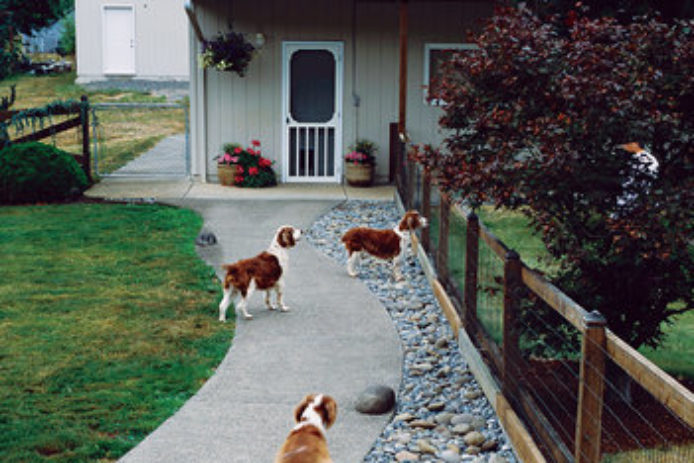Are you tired of your dog constantly running out of your yard? Do you wish you could create a safe and secure space for your furry friend to play in? Well, I’ve got just the solution for you! In this article, we’re going to talk about how you can create a dog-friendly yard with the help of a fence.
Creating a dog-friendly yard is important for the safety and well-being of your precious pup. A fence provides a barrier that keeps your dog from wandering off and getting into trouble, while also keeping potential dangers out. But there’s more to it than just putting up any old fence. In this article, we’ll discuss the different types of fences that are best suited for dogs, how to choose the right height and material, and even some tips on how to train your dog to respect the boundaries of the yard. So, if you’re ready to create a safe and happy space for your furry friend, keep reading to learn more!
How to Create a Dog-Friendly Yard with a Fence

Why a Dog-Friendly Yard with a Fence is Important
A dog-friendly yard with a fence is not only essential for the safety and well-being of your furry friend but also provides a host of benefits. Dogs thrive in outdoor spaces where they can freely explore, play, and exercise. A properly designed and secure yard ensures that your dog can enjoy all these activities without the risk of wandering off or encountering potential dangers.
Benefits of a Dog-Friendly Yard
A dog-friendly yard offers numerous advantages to both dogs and their owners. Firstly, it allows dogs to get the exercise they need, helping to maintain their physical health and prevent obesity. Furthermore, being outdoors stimulates dogs mentally, providing them with mental enrichment and reducing boredom-related destructive behaviors.
A dog-friendly yard also creates a space where dogs can socialize with their owners and other dogs. This strengthens the bond between humans and their pets while providing opportunities for dogs to interact with their own kind.

Importance of a Fence for Dogs
A fence is an essential component of a dog-friendly yard as it provides a boundary that prevents dogs from wandering off or entering potentially dangerous areas. It acts as a physical barrier, protecting dogs from traffic accidents, wildlife confrontations, and other hazards that may be present beyond the yard.
A fence also grants owners peace of mind, knowing that their furry friends are safe and secure within the confines of their property. It allows dogs to have their own space, free from external threats, where they can roam, explore, and play without constant supervision.
Creating a Safe Space for Dogs
When designing a dog-friendly yard, safety should be the primary concern. Creating a safe space involves several considerations, including the size and layout of the yard, escape-proofing measures, and the addition of dog-friendly features.
Size and Layout of the Yard
The size of the yard plays a crucial role in the overall well-being of your dog. Ensure that the yard is large enough to accommodate your dog’s size and exercise needs. A small yard may restrict their movement and limit opportunities for play and exploration. Additionally, consider the layout of the yard, ensuring that there are no hidden corners or areas where your dog could get trapped or injured.
Creating Escape-Proof Boundaries
One of the most important aspects of a dog-friendly yard is the installation of a secure and escape-proof fence. Dogs are naturally curious and may attempt to dig, jump, or squeeze through gaps in the fence. To prevent escape, choose a fence with no gaps large enough for your dog to squeeze through and consider adding an apron or wire mesh buried along the base of the fence to deter digging.
Adding Dog-Friendly Features
Enhance your dog’s experience in the yard by adding dog-friendly features. Consider installing shade structures or trees to provide relief from the sun on hot days. Provide access to clean water at all times by adding a dog-friendly water source. You can also incorporate dog toys, agility equipment, or play structures to keep your furry friend entertained and mentally stimulated.

Choosing the Right Fence for a Dog-Friendly Yard
Choosing an appropriate fence for a dog-friendly yard requires careful consideration. Different factors, such as the temperament of your dog, your budget, and the aesthetics of the fence, should all be taken into account. Here are some key considerations when selecting a dog-friendly fence:
Considerations for Dog-Friendly Fencing
-
Height: Choose a fence height that is appropriate for your dog’s size and jumping ability. Dogs with exceptional jumping skills may require taller fences.
-
Visibility: Some dogs may become anxious in spaces where they cannot see beyond the fence. Consider using materials that allow for visibility, such as chain link or picket fences.
-
Durability: Select a fence material that is strong and durable, able to withstand your dog’s natural tendencies to scratch or chew.
Different Types of Dog-Friendly Fences
There are multiple types of dog-friendly fences to choose from, each with its own advantages and considerations:
-
Chain Link Fences: Chain link fences are popular among dog owners due to their affordability, durability, and visibility. However, they may not provide complete privacy.
-
Vinyl Fences: Vinyl fences are low-maintenance and can mimic the appearance of wood without the need for regular staining or painting. They are also resistant to rot, rust, and pests.
-
Wood Fences: Wood fences are a classic option that offers privacy and aesthetics. However, they may require more maintenance, such as regular staining or painting.
Best Materials for a Dog-Friendly Fence
When it comes to materials, durability is key for a dog-friendly fence. Here are some of the best materials to consider:
-
Aluminum: Aluminum fences are lightweight, durable, and resistant to rust and corrosion. They offer a sleek and modern appearance while providing security for your dog.
-
Steel: Steel is a robust and long-lasting fencing material that can withstand years of wear and tear from dogs. It is highly secure and can be customized to match your aesthetic preferences.
-
Vinyl-Coated Chain Link: If you opt for a chain link fence, consider choosing vinyl-coated chain link. This provides an extra layer of protection against rust and adds an aesthetic appeal to the fence.
-
Cedar Wood: Cedar is a naturally rot-resistant wood that can withstand weather elements and remain durable over time. It offers both privacy and aesthetics.
Designing a Dog-Friendly Yard with a Fence
Designing a dog-friendly yard involves much more than just installing a fence. Taking into account various aspects of the yard’s layout, incorporating escape-proof measures, and adding dog-friendly features are all important considerations.
Size and Layout of the Yard
Consider the size of your dog and the space they need to roam, play, and exercise. A yard that is too small may restrict their movement, while a large yard may require additional fencing or escape-proof measures. Also, be mindful of any potential hazards or obstacles that could pose a risk to your dog’s safety.
Creating Escape-Proof Boundaries
To ensure that your dog cannot escape the yard, it is crucial to create escape-proof boundaries. Regularly inspect the fence for any gaps, holes, or weak points that your dog may exploit. Consider reinforcing the bottom of the fence with an apron or wire mesh to prevent digging, and ensure that gates have secure locks to prevent accidental openings.
Adding Dog-Friendly Features
The inclusion of dog-friendly features in your yard enhances your dog’s overall experience. Consider adding shade structures, such as pergolas or umbrellas, to provide relief from the sun. Planting trees or installing artificial turf can create a comfortable and safe playing surface. Additionally, set up a designated potty area and provide easy access to clean water for your dog’s hydration needs.

Training and Behavior Tips for a Dog-Friendly Yard
While a dog-friendly yard with a secure fence provides a safe space for your furry friend, it is important to address any training and behavior issues that may arise. Here are some tips for effectively training and managing your dog in a dog-friendly yard:
Introducing Dogs to a Fenced Yard
When introducing your dog to a new fenced yard, start with short and supervised sessions. Allow your dog to explore and familiarize themselves with the new environment. Gradually increase the duration of their stay and provide positive reinforcement when they exhibit good behavior within the yard.
Teaching Boundary Training
Teaching boundary training is crucial for preventing dogs from rushing out of open gates or escaping from the yard. Use positive reinforcement techniques to train your dog to stay within the boundaries of the yard. Consistency, patience, and rewards for staying within the designated area will help reinforce this behavior.
Addressing Digging and Jumping Behavior
Some dogs may exhibit digging or jumping behavior, which can compromise the integrity of your yard and fence. Addressing these behaviors early on is important. Provide alternative outlets for these natural behaviors, such as a designated digging area or agility equipment for jumping. Proper exercise and mental stimulation can also help reduce these behaviors.
Maintaining a Dog-Friendly Fence and Yard
To ensure the longevity and functionality of your dog-friendly fence and yard, regular maintenance is essential. Here are some maintenance tasks to keep in mind:
Regular Inspections and Repairs
Regularly inspect the fence for any signs of damage or wear. Replace any broken or loose boards, repair gaps, and ensure the fence is still secure and intact. Additionally, inspect gates, latches, and locks to ensure they are functioning properly.
Cleaning and Sanitizing the Fence
Clean the fence regularly to prevent debris buildup and maintain its appearance. Use mild soap and water to remove any dirt, stains, or grime. If the fence is vinyl or metal, you may also use a pressure washer on a low setting to remove stubborn stains or mold.
Keeping the Yard Free of Hazards
Regularly inspect the yard for any potential hazards that could harm your dog. Remove any toxic plants, sharp objects, or chemicals that are within your dog’s reach. Ensure that all garden tools and equipment are stored in a secure area to prevent accidents.

Landscaping Ideas for a Dog-Friendly Yard with a Fence
Landscaping plays an important role in creating a dog-friendly yard that is both visually appealing and safe for your furry friend. Here are some landscaping ideas to consider:
Choosing Dog-Safe Plants
Select plants that are safe and non-toxic to dogs. Avoid plants that may be harmful if ingested or have thorns that could cause injuries. Some dog-friendly plant options include sunflowers, marigolds, and petunias. Additionally, consider using raised garden beds or planters to prevent dogs from digging or trampling on delicate plants.
Creating Shaded Areas
Provide shaded areas in your yard where your dog can seek relief from the sun. Plant trees or install shade sails, pergolas, or umbrellas to create comfortable spots for your dog to relax. This is especially important during hot summer months to prevent heat-related illnesses.
Adding Water Features
Water features, such as dog-friendly fountains or small shallow pools, can provide entertainment and relief from the heat for your dog. Ensure that any water features are safely constructed and designed with your dog’s enjoyment and safety in mind.
Outdoor Activities for Dogs in a Fenced Yard
A fenced yard opens up a world of outdoor activities and opportunities for your furry friend. Here are some ideas for keeping your dog physically and mentally engaged:
Exercise and Play Opportunities
A spacious yard allows ample room for your dog to run, chase balls, and engage in games of fetch. Set up obstacle courses or create a designated area for playing fetch or Frisbee. Regular exercise not only keeps your dog healthy but also helps alleviate behavioral issues.
Setting up Agility Courses
Agility courses provide mental stimulation and physical exercise for dogs. Utilize tunnels, jumps, weave poles, and other agility equipment to create an engaging and challenging course. This is a great way to bond with your dog and provide them with an outlet for their energy.
Creating a Doggie Obstacle Course
Get creative and design a doggie obstacle course in your yard. Incorporate various elements such as hurdles, balance beams, tunnels, and platforms. This promotes mental and physical stimulation, agility, and coordination for your dog.
Dealing with Common Challenges in a Dog-Friendly Yard
A dog-friendly yard can sometimes come with its fair share of challenges. Here are some common issues and tips for managing them:
Barking and Neighbor Relations
Excessive barking can strain neighborly relations. Train your dog to understand appropriate times to bark and use positive reinforcement to reward quiet behavior. Additionally, provide mental and physical stimulation to keep your dog occupied and less likely to bark out of boredom.
Preventing Fence Fighting
Some dogs may exhibit fence aggression, barking, or lunging at other dogs or passersby. This can put a strain on the neighborhood environment and potentially lead to injuries. Consider using visual barriers, such as privacy slats or planting shrubs along the fence line, to prevent contact and reduce the likelihood of fence fighting.
Managing Access Points
Ensure that gates and access points are properly secured to prevent unintentional escapes. Regularly check for any damage or weaknesses in the gate structure or latch. Train your dog to wait patiently at the gate until given permission to enter or exit, reducing the risk of escapes.
Safety Precautions for a Dog-Friendly Yard
When creating a dog-friendly yard, safety should be a top priority. Implementing safety precautions helps prevent accidents and keeps your dog secure. Here are some important safety measures to consider:
Avoiding Toxins and Chemicals
Keep your yard and garden free from harmful toxins and chemicals. Avoid using pesticides, weed killers, and fertilizers that may be toxic to dogs. Research dog-friendly alternatives or opt for natural pest control methods.
Properly Securing Gates
Ensure that all gates in the yard are properly secured with sturdy latches and locks. Regularly check the integrity of the gate hardware and make any necessary repairs promptly. This prevents accidental gate openings and potential escapes.
Preventing Escape Routes
Inspect the perimeter of the fence to identify any potential escape routes for your dog. Look for gaps, loose boards, or areas where your dog could dig under the fence. Address these issues promptly to prevent escapes and keep your dog safely contained.
Integrating a Dog-Friendly Yard with Other Outdoor Spaces
A dog-friendly yard can seamlessly integrate with other outdoor spaces, providing enjoyment for both dogs and their owners. Here are some ideas for creating a harmonious balance:
Creating a Seamless Design
Choose fencing materials and styles that complement the overall aesthetic of your home and other outdoor areas. Consider coordinating color palettes and textures to create a cohesive look that connects your dog-friendly yard with the rest of your property.
Incorporating Outdoor Seating
Integrate comfortable seating areas into your yard design, allowing you to relax and spend time with your furry friend. Choose durable outdoor furniture that can withstand occasional rough play or doggy paws. Placing seating areas near shaded spots ensures you can enjoy the outdoors together in comfort.
Balancing Dog and Human Needs
When designing your yard, consider both dog-specific features and human needs. Allocate areas for dogs to play freely, while also creating spaces for gardening, entertaining, or relaxation. Establishing clear boundaries and designated sections for different activities will help maintain a harmonious balance.
Budget-Friendly Tips for a Dog-Friendly Yard
Creating a dog-friendly yard doesn’t have to break the bank. Here are some cost-effective tips to consider when designing your dog-friendly space:
Cost-Effective Fencing Options
Choose fencing materials that fit within your budget without compromising quality and durability. Chain link fences are often more affordable compared to wood or vinyl options. Additionally, consider purchasing materials in bulk or during sales to save on costs.
DIY Dog-Friendly Yard Projects
Take on some do-it-yourself projects to save money while creating a dog-friendly yard. Build your own agility equipment using readily available materials or repurpose items to create interactive and engaging features for your dog. DIY projects not only save money but also allow for customization based on your specific requirements.
Saving Money on Maintenance
Proper maintenance can prolong the lifespan of your fence and yard. Regularly clean the fence, trim overgrown branches or shrubs, and address any maintenance issues promptly to prevent costly repairs down the line. Implementing preventive measures and routine upkeep can save you money in the long run.
Benefits of Professional Installation for a Dog-Friendly Fence
While some homeowners may choose to install their own fences, professional installation offers numerous benefits, especially when it comes to creating a dog-friendly yard:
Expert Advice and Recommendations
Professional fence installers have extensive knowledge and experience in creating dog-friendly yards. They can provide expert advice and recommendations based on your specific needs, ensuring the fence design meets both functional and aesthetic requirements.
Efficiency and Quality Assurance
Professional installers have the necessary tools, equipment, and expertise to complete the project efficiently and to a high standard. They are well-versed in local building codes and regulations, ensuring that the fence is installed in compliance with all necessary requirements.
Warranty and Service Benefits
Many professional fence installers offer warranties on their workmanship and materials used. This provides peace of mind knowing that any issues or repairs will be addressed promptly within the warranty period. Additionally, professional installers often provide ongoing maintenance and repair services, ensuring the longevity of your dog-friendly fence.
Local Regulations and Permits for Dog-Friendly Yards
Before embarking on any fence installation project, it is essential to familiarize yourself with local regulations and obtain any necessary permits. Here are some key considerations:
Understanding Zoning Laws
Local zoning laws and ordinances dictate the rules regarding fence height, material choice, and setback requirements for properties. Research the specific regulations applicable to your area to ensure compliance.
Obtaining Necessary Permits
Some localities may require permits for fence installations. Check with your local building department or homeowner’s association to determine the permit requirements and application process. Failure to obtain the necessary permits may result in fines or orders to remove the fence.
Complying with Fence Height Restrictions
Some areas have restrictions on fence height, especially in front yards, to ensure the uniformity and aesthetics of the neighborhood. Familiarize yourself with these restrictions and choose a fence height that complies with local regulations.
Conclusion
Creating a dog-friendly yard with a secure fence is essential for the well-being and safety of your furry friend. It offers numerous benefits, including physical exercise, mental stimulation, and a safe space to explore and play. When designing your dog-friendly yard, consider the size and layout of the yard, create escape-proof boundaries, and incorporate dog-friendly features. Maintenance and regular inspections are vital to ensure the longevity and functionality of the fence and yard. Remember to consider safety precautions, integrate the dog-friendly yard with other outdoor spaces, and explore budget-friendly options. Whether you choose to install the fence yourself or hire professionals, prioritizing your dog’s safety and happiness will result in a truly enjoyable and fulfilling dog-friendly yard.